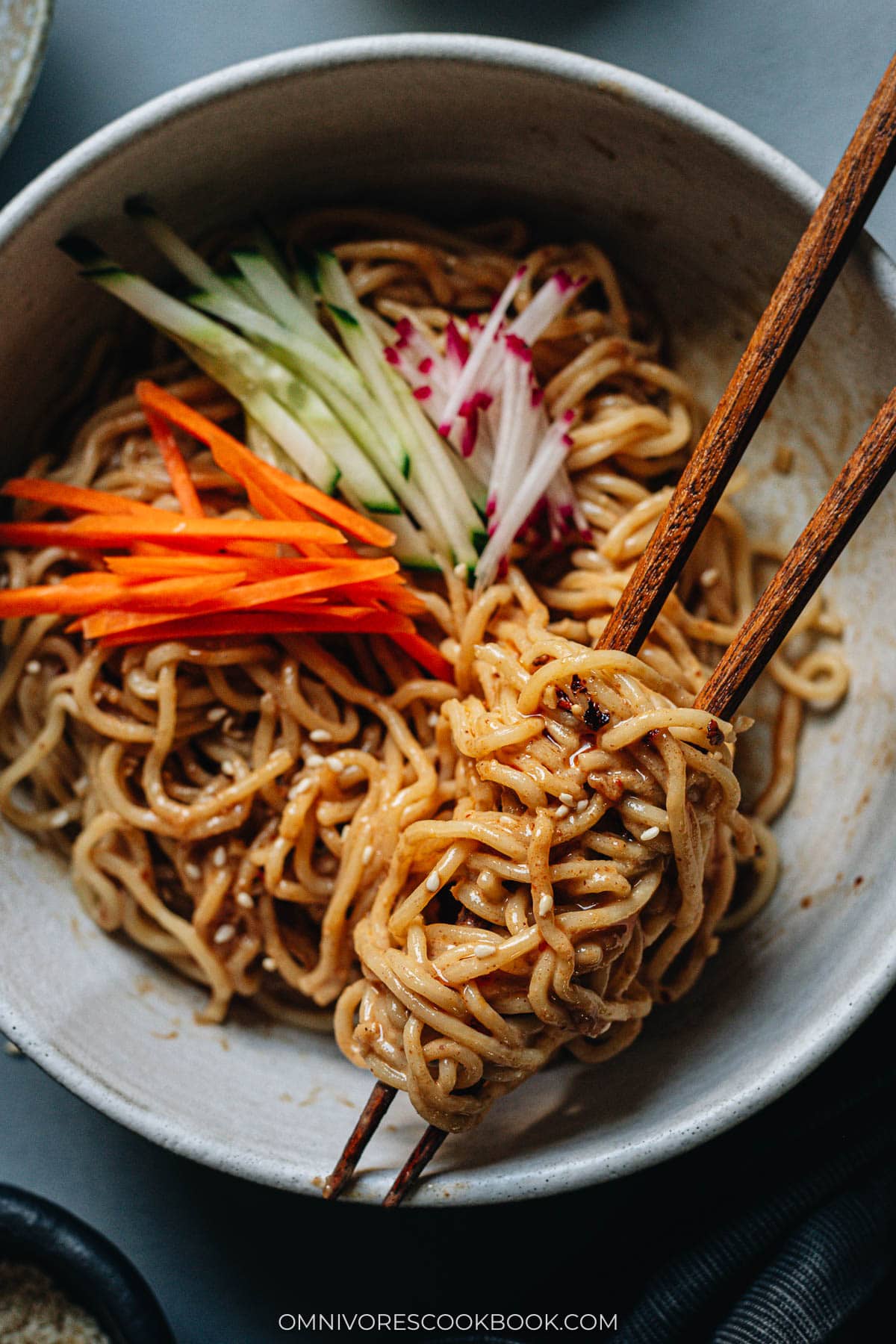
Sesame Noodles: A Symphony of Flavor
Sometimes I hear complaints that Chinese recipes tend to have super long ingredient lists, which scare people away. I couldn’t agree more. The fact is that Chinese cuisine is really good at playing with flavors. It brings together herbs, fermented sauces, and many ingredients that are sweet, salty, sour, and nutty to play a symphony. The tones and rhythms all come together, to create a beautiful melody. Everything is balanced, without a single ingredient jumping out or screaming loudly, just like an Authentic Chinese noodle recipe should be.
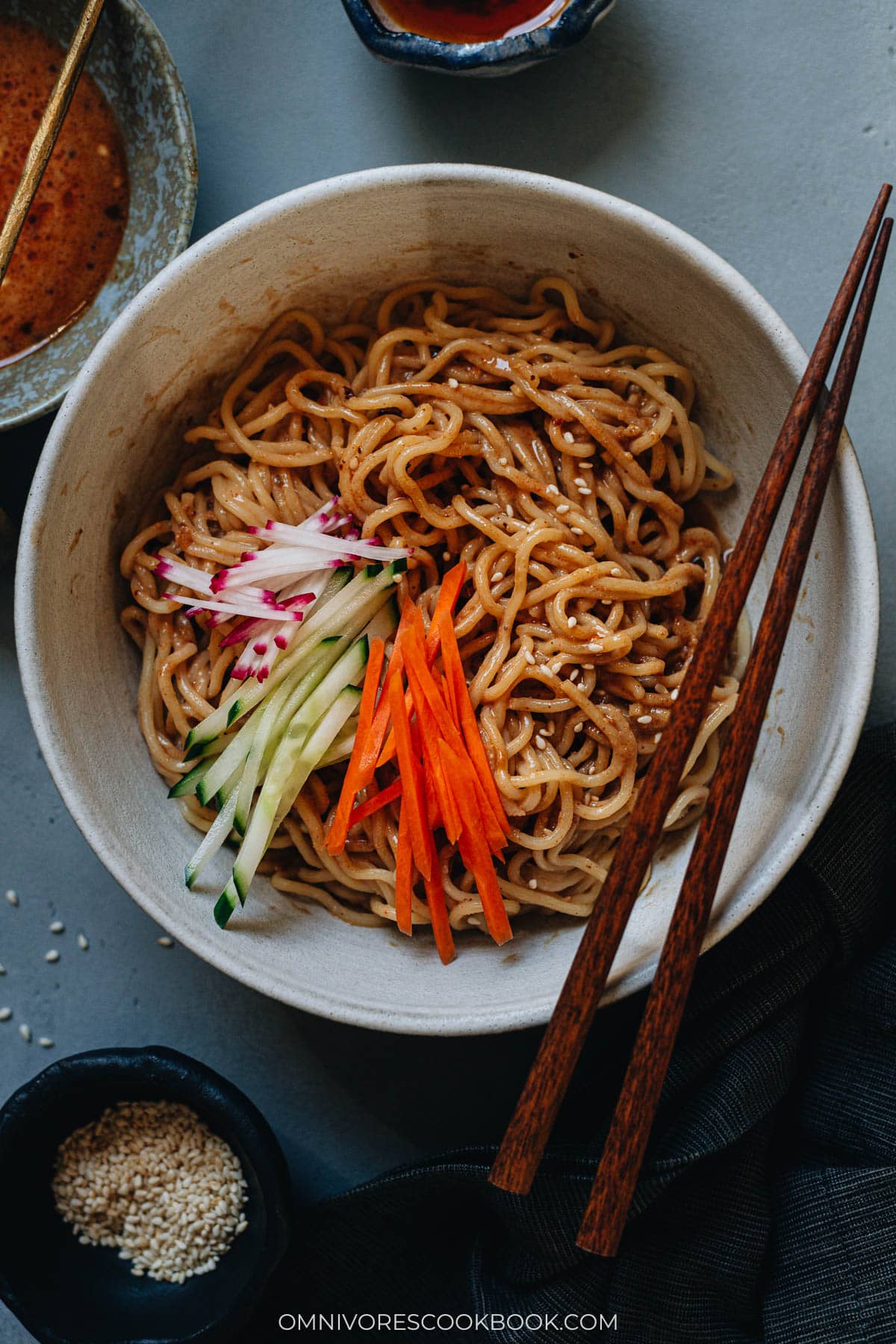
A Lot of Ingredients, Very Easy to Make
For “poor folks’ food” like noodles, the idea is to use the cheapest ingredients to maximize flavor. The goal is to make you happy with a stomach full of noodles, vegetables, and a minimal amount of meat (or no meat at all). A simple sesame noodle dish requires more than 10 ingredients to achieve this goal. In fact, if you count the ingredients needed to make the chili oil, you’ll need about 20 in total.
Sometimes I try to simplify recipes as much as I can, so you can actually make them at home. But in this case, I’d say you need the whole set of ingredients if you want the sauce to be interesting and not just taste like peanut butter.
Ingredients
- Sesame paste
- Light soy sauce
- Chinkiang vinegar
- Maple syrup
- Chili oil
- Sesame oil
- Ginger
- Garlic
- Sichuan peppercorns
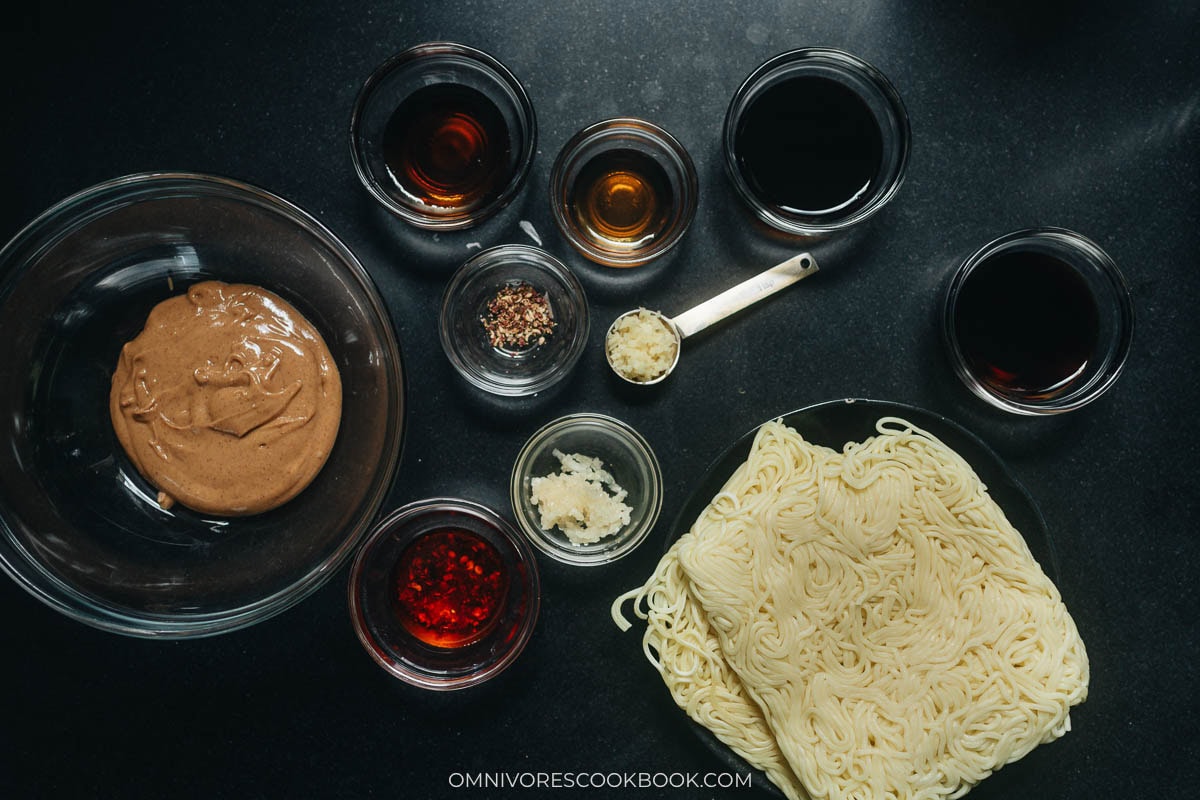
How to make sesame noodles
Making sesame noodles is extremely easy. Because all you need to do is mix the sauce, boiled the noodles, and mix everything together. But here some tips to help you make a better dish:
Mixing the sesame paste with liquid ingredients first: By slowly adding liquid ingredients and mixing them into the sesame paste, it’s very easy to make a thinned out smooth sauce without too much whisking.
Make sure to rinse and drain the noodles once cooked: Boiled noodles release starch. It’s important to rinse the noodles over cold running tap water to rinse off the starch, so the noodles strands separated properly. This way, the noodles have a much nice texture after mixing with the sauce. If you skip the rinsing step, the noodles will clump together and taste gummy after mixing with the sauce.
The Sesame Noodle Sauce isn’t Just for Noodles!
The flip side is that you can make more sauce ahead of time, store it in the fridge, and serve it during the week. For example,
- This sauce makes a very nice vegetable dip.
- It is also a great sauce for zucchini noodles.
- You can use it on roast chicken or leftover meat to make it more interesting.
- And you can thin it out a bit with water and use it as a salad dressing.
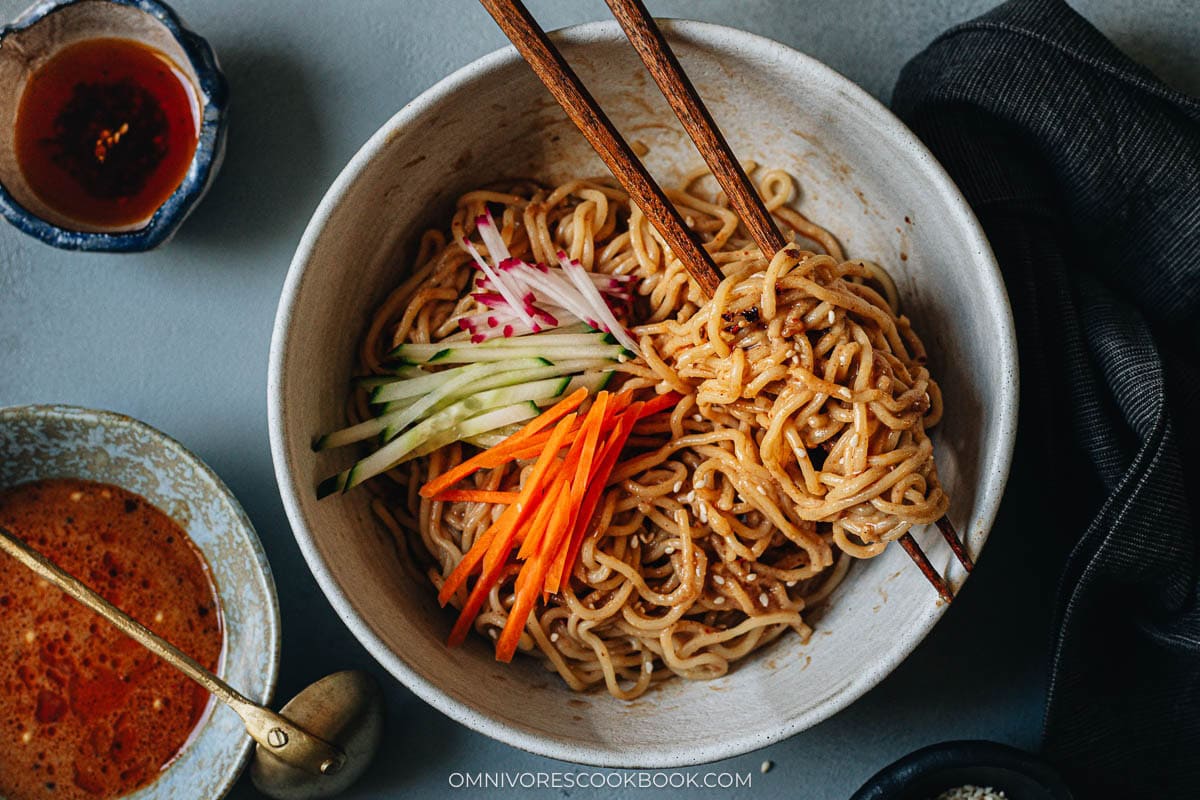
Make Your Own Chili Oil if You Can
The secret ingredients in this recipe are the homemade chili oil and roasted Sichuan peppercorn powder. When I serve this dish at cooking classes and events, I always sneak these two in there so that the noodles will wow everyone. With these ingredients, you can turn “just your average sesame noodles” into “OMG this is so good”.
That being said, if you want to use store-bought chili oil, use Lao Gan Ma (The Godmother Brand) or the Mala Market Chili Oil. Both taste great.
How to Serve Sesame Noodles
You can serve sesame noodles either as an appetizer or a main dish. They are easy to prepare ahead of time and the sauce only gets better after it has been in the fridge a few hours. I might skip (or use very minimal) toppings on the noodles to keep them simple as an appetizer. On the other hand, you can add other things to make it a full meal. For example, leftover shredded meat, sliced avocado, eggs (boiled, poached, or fried), and more vegetables. In this case, make more sauce accordingly.
Consider to use these toppings on sesame noodles:
- Instant Pot Shredded Chicken
- Crispy Tofu with Garlic Sauce (Skip the garlic sauce and use the sesame sauce instead)
- Chinese Braised Beef Shank
- 3-Ingredient Fried Shrimp
- Pickled Daikon with Carrot
Better Too Much Sauce Than Too Little
The last thing I want to emphasize is to always make more sauce than you expect you’ll need. The problem with noodle salad is that you never get the exact amount of sauce correct. Every type and brand of noodles absorbs water and sauce in a different rate. Plus, you might want a bit of extra sauce on the side. The sauce in this recipe is plenty for two big servings or four small servings. But you won’t regret making a double batch in any case.
I hope you enjoy!
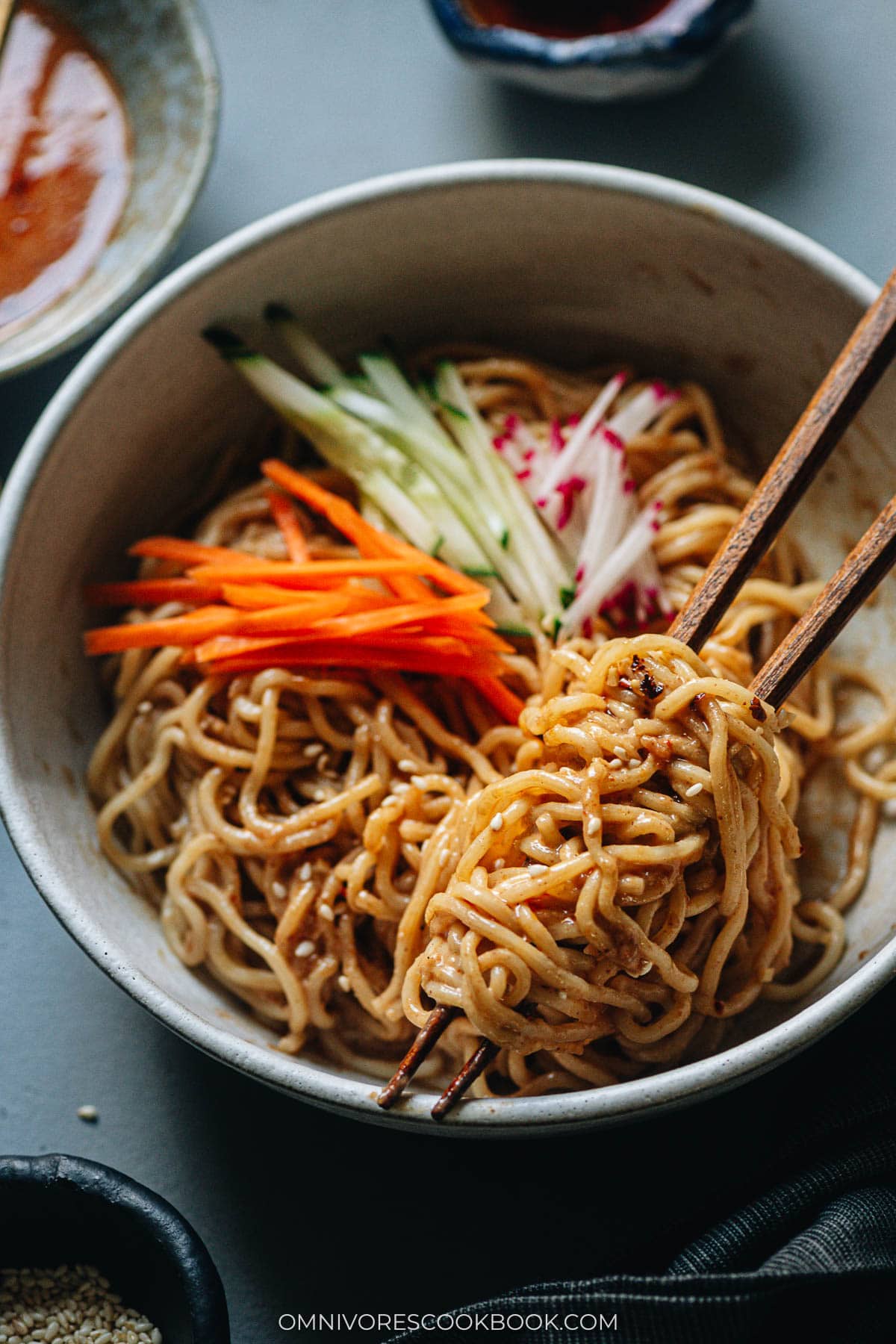
Chinese Cooking Made Easy
Are you new to this website? This free email series is a great place to start. I’ll walk you through a few of my most popular recipes and show you how and why they work. You’ll quickly start to cook better Chinese food in your own kitchen.
Watch video
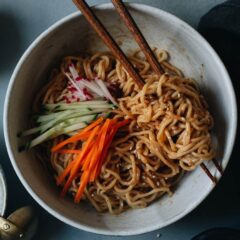
Real Deal Sesame Noodles
Ingredients
- 9 oz dried wheat noodles , or 1 pound (450 g) fresh wheat noodles (*Footnote 1)
Sauce
- 1/4 cup Chinese sesame paste (or unsalted natural peanut butter)
- 2 to 4 tablespoons warm water
- 2 tablespoons light soy sauce (or soy sauce)
- 2 tablespoons Chinkiang vinegar
- 1 tablespoon maple syrup (or sugar)
- 2 teaspoons homemade chili oil (or to taste) (*Footnote 2)
- 1 teaspoon sesame oil
- 1 teaspoon ginger , minced
- 2 cloves garlic , grated
- 1/8 teaspoon freshly ground Sichuan peppercorn powder
Topping options
- Cucumber , cut into thin strips (carrot and / or radish)
- Toasted sesame seeds for garnish
Instructions
- Add Chinese sesame paste to a medium size bowl and slowly add 2 tablespoons water, a little at a time. Stir with a spatula until the water is fully incorporated and it forms a smooth paste.
- One liquid ingredient at a time, add light soy sauce, Chinkiang vinegar, maple syrup, chili oil, and sesame oil, fully stir to incooperate each ingredient before adding the next one.
- Add the ginger, garlic, and Sichuan peppercorn powder. Stir to mix well. You can make the sauce ahead of time and store it in the fridge for 2 to 3 days.
- Boil noodles according to instructions. Transfer cooked noodles into a colander, rinse with tap water to stop the cooking. Drain well and transfer to small serving bowls.
- Serve the noodles with the sauce on the side with toppings of your preference.
- To eat, assemble your own bowl with any toppings you prefer, add a few spoonsful of the sauce. Mix and enjoy.
Notes
- The sauce in this dish is so flavorful and versatile that you can use many types of wheat noodles for a great result. For a traditional taste, try out lo mein noodles. Udon noodles and somen noodles work great as well.
- The homemade chili oil is usually served separately and added according to personal taste. I personally prefer to use a small amount in the sauce because it adds a very fragrant umami that makes the sauce stand out. Always ask your guests if they can handle a bit spiciness. If not, serve the chili oil separately with the noodles.
- The quantity of the sauce and noodle depend on many factors such as how many toppings you use, the type of noodles, and personal taste. The recipe is a good starting point that can general 2 big servings with some fresh produce toppings. Double the sauce if you plan on using more toppings.
Nutrition

Did you make this recipe?
I’d love to hear how it turned out for you! Please take a moment to leave a 5-star rating ⭐️ and share your thoughts in the comments further down the page. It really helps others discover the recipe too.

Caro
Can i use sphaghetti noodles?
Thanks
Maggie Zhu
Yes, you definitely can!
Jeffrey Undercoffer
This is my go to Sesame Noodle recipe. Instead of a teaspoon of chili oil (I use Maggie’s recipe for home made chili oil) I add two tablespoons of Spicy Chili Crisp (I love heat) and top with scallions. I also use 1/2 peanut butter and 1/2 sesame paste.
A word about Maggie. I love her recipes, her entrepreneurial spirit, and the fact she transitioned from China to the USA. She and people like her are what makes America great.
Anne
Maggie, is there a way to have this as a warm sauce? Anything to watch out for? Would it possibly separate? It’s January and I feel like a nice warm sesame dish. Thanks!
Maggie Zhu
After mixing the noodles with the sauce, you can heat it up in the microwave. The sauce might become a bit sticky, which you can always use a little water (or even better, chili oil) to thin it out. I think it works better to heat up the noodles after mixing than just heating up the sauce.
PS. Just want to emphasize that you should always rinse the noodles with running tap water after boiling them, even if you need to heat up the noodles later. The rinsing is very important – it removes the starch from the noodles, so they have a nice texture after mixing with the sauce. Without rinsing, the noodles will become very gummy and stick together after mixing the sauce.
Anne
Thank you, Maggie! I made it like you recommended, and it worked perfectly. I love your book, btw, it’s so beautiful and of such great quality. One more question, please: It’s really difficult for me to find either of the two chili oils you mention in your book, and Chinese chilis for making my own oil are also not to come by. Everything here (central Texas) in relation to chilis is always just heat (the more the better), not any of the complexity of chilis you describe. We don’t like spicy food. Do you by now have any other brands you could recommend? Thank you!!!
mimi
I’m OBSESSED with this recipe and your blog. For a large dinner party, I made these noodles, your Crispy Marinated Tofu, and your Chinese Coleslaw. I followed the recipes exactly and everyone loved it and asked for recipe links. Everything I’ve made from Omnivore’s Cookbook is delicious and it’s exciting to use ingredients/methods that are new to me. I need to check out your husband’s site too. Thank you so much!! (written while eating these noodles)
Maggie Zhu
So happy to hear that you had a successful dinner party and thanks for the shoutout for my blog! 🙂
Recipe land
Love this recipe
Glenn Davis
One of my favorites on the site. Used half half organic unsalted peanut butter and sesame paste from China which is available at 99 Ranch market in my locale.